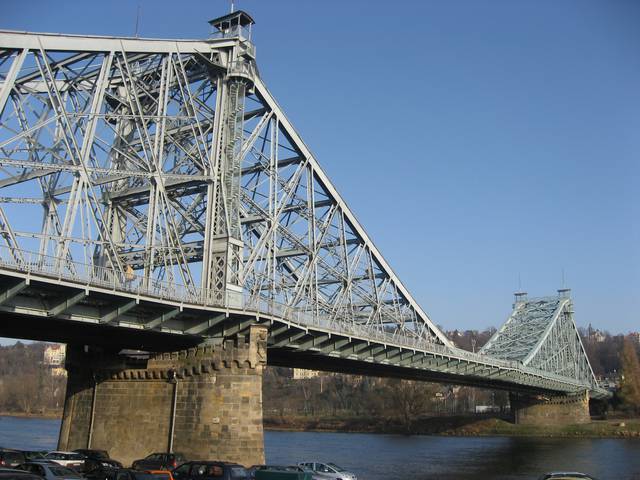

Loschwitz Bridge is a cantilever truss bridge over the river Elbe in Dresden the capital of Saxony in Germany. It connects the city districts of Blasewitz and Loschwitz, two affluent residential areas, which around 1900 were amongst the most expensive in Europe. It is located close to Standseilbahn Dresden funicular railway and the world's oldest suspension railway Schwebebahn Dresden, as well as near the Dresden TV tower. The bridge is colloquial referred to as Blaues Wunder. This common name supposedly referred to the bridge's original blue colour and being seen as a technological miracle at the time; alternatively it may have alluded to the sceptical view of commentators at the time about the construction, as contained in the idiomatic phrase in German (ein blaues Wunder erleben) "to experience an unpleasant surprise".
After a two-year construction time, the bridge was completed in 1893 at a cost of 2.25 million Goldmarks and named König-Albert-Brücke in honor of King Albert of Saxony. In the 19th century it was a masterpiece of technology to build a bridge of this length without river piers supporting it. Today its technology is less of a miracle but it is a much-loved symbol of the city.
The original bridge toll was renounced during the 1923 hyperinflation. In the last days of World War II two people saved the bridge from being blown up by an SS unit, by cutting the detonator wires to the explosives. Preserved in its original construction, the advanced age of the structure in recent years has led to some traffic limiting. It was until the opening of the Waldschlösschenbrücke on 26 August 2013 the only Elbe crossing in Dresden East of the city centre.
The surrounding area of 19.3sqkm of the Elbe meadows was declared a cultural World Heritage Site by the UNESCO in 2004, but lost the title in 2009 in reaction to the construction of the aforementioned Waldschlösschenbrücke, which is meant to relieve the Blue Wonder.
